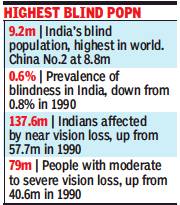Eyesight, vision issues: India
This is a collection of articles archived for the excellence of their content. |
Contents |
The magnitude of the health issues
1990> 2020
Shobita Dhar, Near vision loss cases in India surge to 138m, October 20, 2020: The Times of India

From: Shobita Dhar, Near vision loss cases in India surge to 138m, October 20, 2020: The Times of India
New Delhi:
Increased life expectancy and a high diabetes burden has increased the number of Indians with eyesight issues. Cases of near vision loss have more than doubled in the country — from 57.7 million in 1990 to 137.6 million in 2020, according to new data provided by two international bodies.
Near vision loss means inability to focus on nearby objects — it’s also called presbyopia — and sets in from the mid-40s. In a new data analysis which took six to seven years to compile, the Vision Loss Expert Group (VLEG) and the International Agency for the Prevention of Blindness (IAPB) found that there were 507 million cases of near vision loss in the world, with 137.6 million of them in India.
IN LINE OF SIGHT
One in six diabetics in India suffers from retinopathy: IAPB survey
The data also revealed that cases of moderate and severe visual impairment (MSVI) have almost doubled from 40.6 million in 1990 to 79 million in 2020 in India. Moderate and severe vision loss is when visual acuity is less than 6/18 to 3/60 (if a patient has a vision of 3/60, it means she is able to see from three feet what a person with perfect vision can see from 60 feet). Blindness is when visual acuity is less than 3/60. A leading cause of MSVI is diabetes, said experts. In 2016, India had 65 million diabetics, according to a Lancet paper.
The latest IAPB survey found that about 1 in 6 diabetics in India suffers from retinopathy. “Untreated visual impairment due to diabetic retinopathy, cataract, glaucoma and certain corneal conditions can lead to blindness. These factors account for about 65% of all MSVI cases in India,” said Dr Vinay Nangia, ophthalmologist and lead for the Vision Loss Expert Group, South Asia. Another factor behind rise in vision problems is increased life expectancy of Indians, experts said. A recent paper in Lancet had found that India’s life expectancy had increased from 59 years in 1990 to 70 years in 2019. The new survey found that 78% of blind people were above the age of 50 years.
With a blind population of 9.2 million, India is still home to the world’s largest number of blind people followed by China at 8.9 million people.
Glaucoma
2022: Mutant gene identified
Umesh.Isalkar , March 28, 2022: The Times of India
Pune: A team of eye surgeons in Maharashtra have identified a particular “mutant gene” that makes Indian citizens prone to glaucoma — a leading cause of blindness.
The finding has paved the way to developing screening tools — targeting the diseasecausing gene variation/mutation — which will make early diagnosis and treatment possible. Over 50% of glaucoma cases remain undi agnosed until irreversible optic nerve damage has occurred. The research is an ongoing collaborative project among eye surgeons in Pune, Sangli, along with researchers in Ireland. The Institutional Review Board and Ethics Committee at PBMA’s H V Desai Eye Hospital, Deenanath Mangeshkar Hospital, Pune, and the Indian Council of Medical Council (ICMR), New Delhi, have approved the study.
“If we develop genetic screening tests to identify this particular gene mutant (LOXL1 risk alleles) from blood or saliva samples from the population, it can assist in early diagnosis and treatment of gla ucoma. Our research has paved the way for the development of effective new diagnostics and early treatment,” said eye surgeon and study’s lead investigator Dr Chitra Sambare. Over -expression of some mutant (LOXL1) proteins (R141L and G153D) in the eye cell line can result in altered processing resulting in developing glaucoma.
Such dysregulation of mutant gene/proteins may simpl y be a contributing factor to development of glaucoma in addition to other risk factors, including raised intraocular pressure, oxidative stress and ultraviolet (UV) light, the researchers have said.
Besides, family history of glaucoma is also a strong predictor, and a potential useful tool in clinical risk assessment.
Incidentally, many forms of glaucomahave no warning signs. The effect is so gradual that one may not notice a change in vision until the condition is at an advanced stage.
Among them, pseudoexfoliation glaucoma (XFG) is the most common form of openangle glaucoma. The specific genetic mutatio n identified by the researchers is significantly linked with the XFG, which is known for aggressive and rapid loss of vision.
“In addition to Scandinavian countries, there is a high prevalence of XFG in the Indian population, especially the western part of India, who carry a variant (mutation) in the LOXL1 gene that is a significant risk factor for pseudoexfoliation glaucoma. Our collaborativ e research has made it very clear,” said Punebased eye surgeon and study’s key researcher Dr Aditya Kelkar of the National Institute of Ophthalmology (NIO).
The study’s other researchers and glauco ma experts include Dr Medha Prabhudesai, Dr Tejaswini Walimbe, Dr Milind Killedar and Dr Vidya Cherlekar.
“This is the first genetic study that has been carried out in the population living in the western part of India, mainly Maharashtra. Two studies carried out in south Indian (Chennai and Madurai) p opulation in the past had found the same genetic mutation (LOXL1) that makes people pr one to getting the glaucoma (XFG) that we have identified in the population living in the western part/Maharashtra,” Dr Kelkar said.
But the third study carried out in the north Indian (Punja b/Chandigarh) population in the past showed different genetic mutations linked with the glaucoma, he added.
Glaucoma is the second leading cause of blindness in the adult population in India affecting 12 million people and is r esponsible for 12. 8% of the total blindness in India.